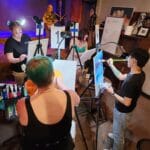Your cart is currently empty!
The art world stands at the crossroads of innovation and tradition as artificial intelligence reshapes what it means to create. Programs like DALL-E, MidJourney, and Stable Diffusion are empowering artists—and anyone with a spark of curiosity—to generate intricate, stunning artworks with just a few words. For some, this represents an unprecedented era of artistic exploration; for others, it raises unsettling questions about authorship, creativity, and authenticity.
Let us pause to consider: Is AI an artistic tool, a collaborator, or a competitor?
The Creative Potential of AI
AI art programs analyze vast datasets of images and styles to produce works that can mimic the brush strokes of Van Gogh, the surrealism of Dali, or the precision of photorealism. Artists like Mario Klingemann and Refik Anadol are already using AI to expand their creative horizons, blending machine learning with human intention. These tools have made art more accessible than ever before, empowering individuals without formal training to produce gallery-worthy pieces.
But does accessibility dilute the sanctity of art, or does it democratize an often-exclusive world? How do you see this shaping the future of creativity?
The Debate Over Authorship
A thornier question lies in the authorship of AI-generated works. If an artist prompts a machine to “paint” a masterpiece, who is the creator—the human who provided the vision, or the algorithm that did the work? And what of the datasets that train AI models? Many are built using existing artworks, often without the consent or knowledge of the original creators.
This has sparked heated debates in the art community. Some see AI as a tool, no different from a paintbrush or a camera, while others argue that relying on AI erodes the very essence of human creativity.
What is your stance? Does AI undermine the value of human-made art, or does it simply expand the toolkit available to today’s artists?
Art’s Future in the Machine Age
As AI art floods galleries, marketplaces, and social media, traditional definitions of art and artistry are being rewritten. The rise of AI challenges us to consider art’s role in society: Is art valuable because of the skill it requires? Because of the emotional connection it fosters? Or simply because it exists?
Consider the viral popularity of AI-generated works like the surreal “Cosmic Opera” series or the digital reimaginings of classic paintings. These pieces captivate audiences, but will their novelty endure? Will AI remain a creative collaborator, or will it become an artistic force unto itself?
Join the Conversation
The intersection of art and AI is brimming with possibilities, challenges, and ethical dilemmas. How do you feel about this brave new world?
Have you experimented with AI art tools?
Do you see AI-generated art as a legitimate form of creativity?
Should there be stricter rules about how AI programs use existing art to “learn”?
We want to hear your thoughts, experiences, and questions. Share your perspectives, or post examples of AI art you’ve created or encountered. Let’s explore together how technology is reshaping our creative identities and the world of art itself.
Art is evolving—what will its next chapter hold? Join the discussion below and let your voice shape the narrative!
personally, one of the most interesting things that the rise of ai generated art questions is the concept of “stealing like an artist”.
I think inspiration is a fundamental part of art simply due to the way the human brain is wired. we cannot create without accessing all of the things that we have been exposed to, even if we are not fully conscious of it. many artists push for the idea of “stealing” or gathering the elements of other artists that resonate with you to create something of your own. if you look at the timeline of art history, you can see how all of these different artworks build off each other or sometimes are a direct opposition. and now, we are at a point where technology can replicate this process of merging learned elements to create something “new”. in a way, you can see certain ai art programs that work solely off prompts, as a collaboration between two “entities”, where at times the human seems to be doing the least amount of work and decision making. almost like a commission of some sort. but if we take a look at conceptual art, especially readymades, the value or the work lies mostly in the ideas and questions it presents rather than the skill it took to make them. many times consisting of objects presented as art that weren’t made by the artist who takes ownership of it.
I wouldn’t say I’m opposed to artificial intelligence in the art world. I think it presents new and exciting methods of creating. again, it can be seen as an experiment between human and program, with a final result that can be such a mystery until it reveals itself. this topic always makes me think of a work that was presented to me in a technology and art course, where an artist created a series of poems through an algorithm she programmed. it had a limited data set of words and many of the poems read a bit incoherently, but there was something intriguing about them, a wide array of possible interpretations.
although trying to stay open minded, I think it’s very important to discuss the place of ownership in this innovation and question whether it will diminish the value/need for human made art. Like mentioned, many artists have been victims of having their artwork submitted to these datasets without their consent, resulting in pieces that are almost identical to their work but are now being displayed by a different ‘owner’ for different purposes. and this can happen outside of ai, with an artist physically recreating the work of another, but even then, there is a sort of credit in the labor it took to create it, and also a human flaw that makes it impossible to have an exact replica. all of this to say, there is definitely space for regulation that protects human artists.



